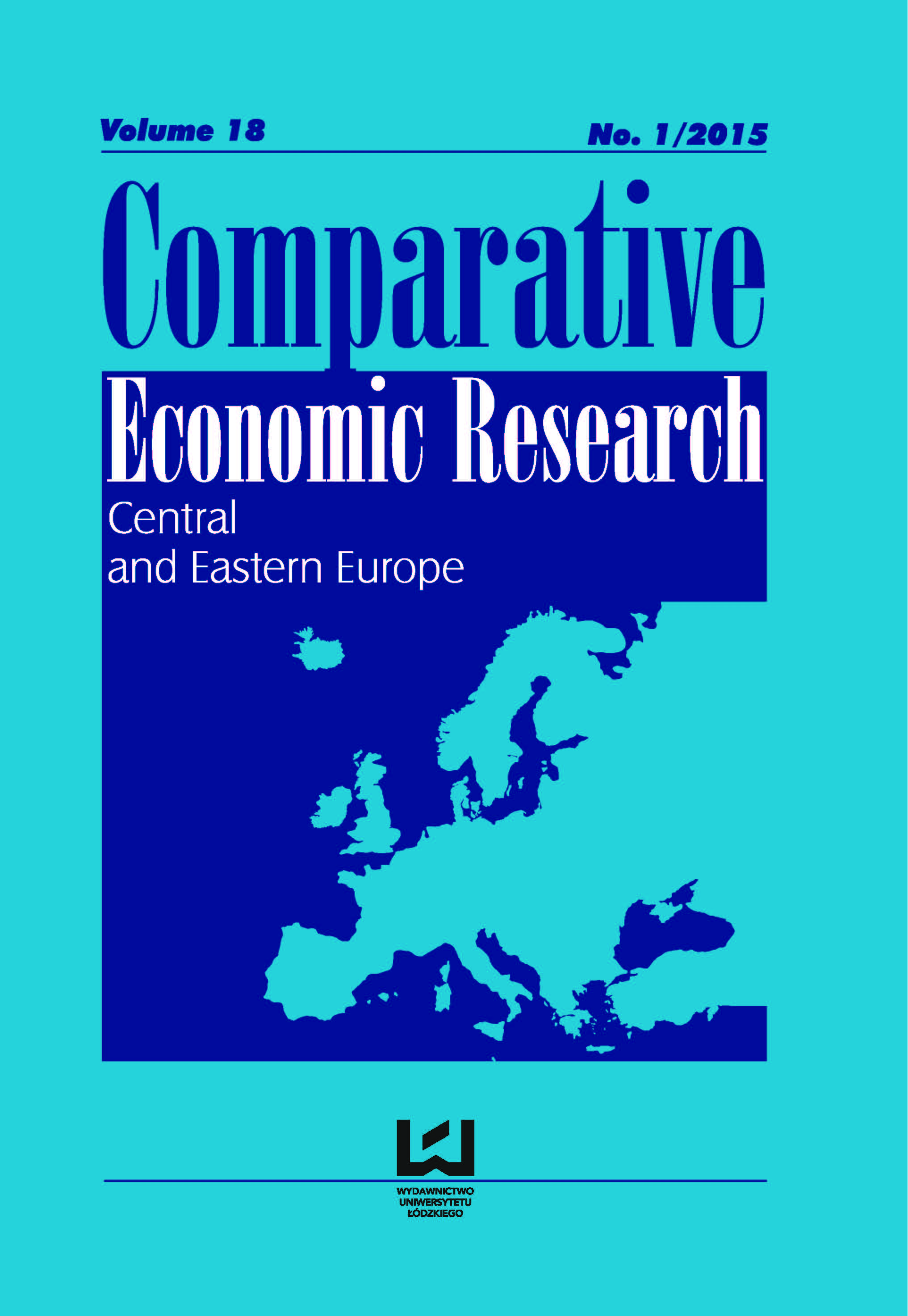The Rich North-west, The Poor Middle-east – Consumption In EU Households
DOI:
https://doi.org/10.1515/cer-2015-0003Keywords:
households, EU, consumer expenditures, disproportionsAbstract
The aim of paper is to analyze household consumption in EU countries in the 21st century. The two hypotheses posited have been confirmed. The start of the 21st century saw an increase in consumer spending in EU households and reduction in the disparities between households of different countries. At the end of the first decade there was a stabilization in consumer spending. The differences in consumption between households can be considered as a) the effect of freedom of choice, and b) a consequence of specific restrictions that do not allow for an appropriate level of funds to meet household needs. Households with the most favourable situation are located in the United Kingdom and Austria. The most unfavourable situation can be observed in the households of Estonia, Latvia, Poland, Romania and Bulgaria.
Downloads
References
Albu, L. L. (2012). Trends In Income Distribution, Romanian Journal of Economics, 35.2 (44), pp. 33-44.
Google Scholar
Albu, L. L (2012a). Structural Convergence in European Union, Annals - Economy Series, Constantin Brancusi University, Faculty of Economics, 4, pp. 1-10.
Google Scholar
Albu, L. L (2012b). The Convergence Process in the EU Estimated by Gini Coefficients, ‘Journal for Economic Forecasting’, 4, pp. 5-16.
Google Scholar
Bogović, N. D. (2002). Long-term characteristics of personal consumption in the Republic of Croatia, Economic Review, Vol.53 No.7-8, pp. 622 – 639.
Google Scholar
Bywalec Cz. (2012). Ekonomika i finanse gospodarstw domowych, Wydawnictwo Naukowe PWN, Warszawa.
Google Scholar
Bywalec Cz. (2007), Konsumpcja w teorii i praktyce gospodarowania, Wydawnictwo Naukowe PWN, Warszawa.
Google Scholar
Household Budget Survey in 2011 (2012). Central Statistical Office, Warsaw.
Google Scholar
Burns R. B. and Burns R. A. (2008). Business Research Methods and Statistics using SPSS SAGE Publications Ltd [online] Available at: http://www.uk.sagepub.com/burns/website%20material/Chapter%2023%20-%20Cluster%20Analysis.pdf [Accessed in December 2013].
Google Scholar
Cermakova J. (2001). The Influence of Income Differentiation on the Structure of Household Expenditures, Finance a uver??, 51, 1, pp.33-45.
Google Scholar
Dąbrowska A. (2011). Consumer behaviour in the market of catering services in selected countries of Central+Eastern Europe, British Food Journal, 113 (1), 96-108.
Google Scholar
Eurostat – OECD (2005). Methodological manual on purchasing power parities. Methods and nomencaltures. European Commission, OECD, Eurostat, Theme Economy and finance, Luxembourg.
Google Scholar
Eurostat. Database 2012. [online] Available at: http://epp.eurostat.ec.europa.eu/portal/page/portal/information_society/data/database. [Accessed in December 2013].
Google Scholar
Eurosystem Household Finance and Consumption Network. Results from the first wave, 2013. European Central Bank, Germany.
Google Scholar
Evans I. S. (1977). The selection of class intervals. Transactions of the Institute of British Geographers, New Series, Vol. 2, No 1, pp. 98-124.
Google Scholar
Gerstberger Ch., Yaneva D. (2013). Analysis of EU-27 household final consumption expenditure – Baltic countries and Greed still suffering most from the economic and financial crisis. Eurostat, Economy and finance, Statistics in focus, 2.
Google Scholar
Glick R.; Lansing K. J. (2010). Global household leverage, house prices and consumption. FRBSF Economic Letter, 1.
Google Scholar
Gutkowska K., Laskowski, W., Ozimek, I. (2012). Konsumpcja żywności w polskich gospodarstwach domowych – kryteria zróżnicowania. Wydawnictwo SGGW.
Google Scholar
Human Development Report 2013. The Rise of the South: Human Progress in a Diverse World. UNDP, New York.
Google Scholar
Janoś-Kresło M. (2006). Cechy konsumentów i gospodarstw domowych jako podmiotów konsumpcji. [in:] Janoś-Kresło M., Mróz B.: Konsument i konsumpcja we współczesnej gospodarce, Szkoła Główna Handlowa w Warszawie, Warszawa.
Google Scholar
MacQueen J. B. (1967). Some Methods for classification and Analysis of Multivariate Observations, Proceedings of 5-th Berkeley Symposium on Mathematical Statistics and Probability, Berkeley, University of California Press, 1, pp. 281-297.
Google Scholar
Piekut M. (2008). Polskie gospodarstwa domowe – dochody, wydatki i wyposażenie w dobra trwałego użytkowania. Warszawa, Wydawnictwo SGGW.
Google Scholar
Piekut M. (2009). Polaryzacja konsumpcji w gospodarstwach domowych, Wiadomości Statystyczne, 7, pp. 55-68.
Google Scholar
Piekut M. (2013). Konsumpcja w polskich gospodarstwach domowych na tle krajów europejskich, ‘Problemy Zarządzania’, 11, 1 (40), t.1, pp. 23-39.
Google Scholar
Volkswirtschaftliche Gesamtrechnungen. Private Konsumasugaben unf Verfugbares Einkommen. 2012. Wiesbaden: Statistiches Bundesamt.
Google Scholar
Ward J. H. (1963). Hierarchical grouping to optimize an objective function, ‘Journal of the American Statistical Association’, 58, 301, pp. 236-244.
Google Scholar
Zalega T. (2013). Spożycie produktów żywnościowych w wielkomiejskich gospodarstwach domowych w Polsce w okresie kryzysu finansowo-ekonomicznego, ‘Problemy Zarządzania’, 11, 1 (40), t.1, pp. 68-87.
Google Scholar
Downloads
Published
How to Cite
Issue
Section
License

This work is licensed under a Creative Commons Attribution-NonCommercial-NoDerivatives 4.0 International License.











